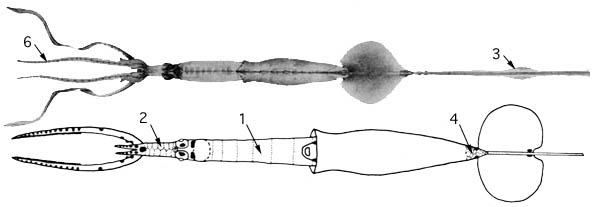Chiroteuthid Doratopsis Stage
Richard E. Young and Clyde F. E. Roper
Doratopsis paralarvae possess the following characteristics at some point, at least, in their development:
- Elongate, chambered neck.
- Chambered brachial pillar.
- Gladius extending posteriorly beyond fins and supporting floatation structures or "ornamentation."
- Vesicular tissue in posterior region of mantle just anterior to fins.
- Vesiculate arms in advanced stages.

Click on an image to view larger version & data in a new window

Figure. Oral view of portion of arm IV of Planctoteuthis exopthalmica, 9.5 mm ML, showing vesiculate tissue. Drawing from Chun (1910).
- Ventral arms greatly elongate in advanced stages.
- Tentacular clubs of advanced stages with keels parallel to dorsal protective membranes along most of club length.

Click on an image to view larger version & data in a new window

Figure. Oral view of a tentacle from an unidentified doratopsis, 28 mm ML. Note the paralarval club with both large suckers and a keel (but without division into manus and dactylus) and also the presumptive adult club of small suckers on the tentacular stalk. Drawing from Roper and Young, 1967.

Click on an image to view larger version & data in a new window

Figure. Oral view of the distal region of a clubs of C. calyx in transition from the paralarval stage showing adult club (right) with terminal paralarval club still intact, damaged mantle estimated at 70 mm ML. Club much more advanced than that in previous drawing. Photograph by R. Young.
Most of these features are seen in these drawings of the doratopsis stage (numbers correspond to character numbers above):

Click on an image to view larger version & data in a new window

Figure. Top - Dorsal view of late doratopsis stage of Chiroteuthis veranyi, 35 mm ML. Drawing from Pfeffer, 1912. Bottom - Ventral view of a middle doratopsis stage of Chiroteuthis spoeli, 9.6 mm ML. Drawing from Young, 1991.
References
Chun, C. 1910. Die Cephalopoden. Oegopsida. Wissenschaftliche Ergebnisse der Deutschen Tiefsee Expedition auf dem Dampfer "Valdivia" 1898-1899, 18(1):1-401.
Pfeffer, G. 1912. Die Cephalopoden der Plankton-Expedition. Ergebniss der Plankton-Expedition der Humboldt-Stiftung. 2: 1-815.
Roper, C. F. E. and R. E. Young (1967). A review of the Valbyteuthidae and an evaluation of its relationship with the Chiroteuthidae. Proc. U.S. Nat. Mus., 123: 1-9.
Young, R. E. (1991). Chiroteuthid and related paralarvae from Hawaiian waters. Bull. Mar. Sci., 49: 162-185.
About This Page

University of Hawaii, Honolulu, HI, USA

Smithsonian Institution, Washington, D. C., USA
Page copyright © 1999 and
 Page: Tree of Life
Chiroteuthid Doratopsis Stage
Authored by
Richard E. Young and Clyde F. E. Roper.
The TEXT of this page is licensed under the
Creative Commons Attribution-NonCommercial License - Version 3.0. Note that images and other media
featured on this page are each governed by their own license, and they may or may not be available
for reuse. Click on an image or a media link to access the media data window, which provides the
relevant licensing information. For the general terms and conditions of ToL material reuse and
redistribution, please see the Tree of Life Copyright
Policies.
Page: Tree of Life
Chiroteuthid Doratopsis Stage
Authored by
Richard E. Young and Clyde F. E. Roper.
The TEXT of this page is licensed under the
Creative Commons Attribution-NonCommercial License - Version 3.0. Note that images and other media
featured on this page are each governed by their own license, and they may or may not be available
for reuse. Click on an image or a media link to access the media data window, which provides the
relevant licensing information. For the general terms and conditions of ToL material reuse and
redistribution, please see the Tree of Life Copyright
Policies.
 Click on an image to view larger version & data in a new window
Click on an image to view larger version & data in a new window
 Click on an image to view larger version & data in a new window
Click on an image to view larger version & data in a new window






 Go to quick links
Go to quick search
Go to navigation for this section of the ToL site
Go to detailed links for the ToL site
Go to quick links
Go to quick search
Go to navigation for this section of the ToL site
Go to detailed links for the ToL site